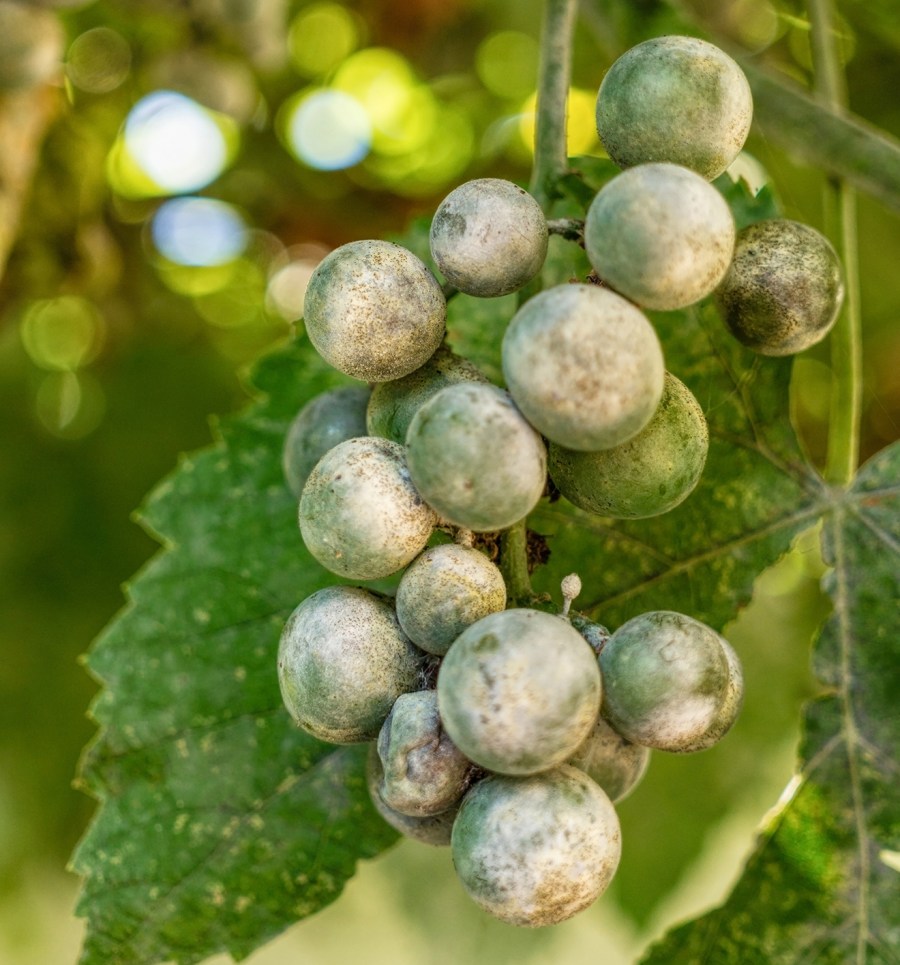Flowering is a crucial time to guard against key diseases establishing in vines, particularly Botrytis, as Hutchinsons agronomists Rob Saunders and Chris Cooper explain.
The cool, damp start to spring has slowed bud development, but with some sunshine and heat, inflorescences are quickly becoming visible. Although behind the 2022 season by 7-10 days, generally flower initiation has been good, with little frost damage to date, plus a reasonably even bud break.
The 2023 crop looks very promising, although it is important to be realistic about the quality and quantity vines can support and carry through to harvest.
Flowering is a critical time for disease control. The fast, lush growth from primary buds, which if combined with prolonged flowering due to cool, wet conditions, provides ideal opportunities for infection, especially as flowers and inflorescences, where caps don’t dislodge, offer an entry point for Botrytis.
Tackling Downy mildew
Preventing establishment of Downy mildew around now is difficult, due to warm, wet conditions with plenty of lush green leaves to infect.
Early application of products that enhance the plant’s resilience to stressful conditions, such as Procrop ISR (a blend of natural ingredients), and Zynergy, can be a useful part of the overall crop management strategy.
At this growth stage it will be time to add in something more robust though. Fungicides are relatively limited, with the main options being potassium phosphite, ametoctradin + dimethomorph, metalaxyl-M, cymoxanil, or amisulbrom.
Managing Botrytis early
Another disease priority at flowering is Botrytis. Latent Botrytis infection can remain ‘hidden’ until developing berries begin to soften in late summer/early autumn, when the concentration of natural anti-fungal compounds declines, and disease develops, causing rots to occur.
Now is the time to monitor vineyards for Light Brown Apple Moths (LBAM) with pheromone traps, and treat as required. Should LBAM be permitted to feed within inflorescences, berries will be lost or damaged, and Botrytis risk is increased.
There is a good armoury of botryticides available for use later in the season, however, on high-yielding sites and tight bunch varieties, such as some Pinot, Chardonnay, or Bacchus clones, it may be feasible to help reduce Botrytis risk by altering bunch architecture at flowering.
The turgor pressure that builds up as berries swell in tight bunches can cause some in the middle of the bunch to split, releasing juice that will raise the risk of Botrytis. Decompacting the bunch, allowing a greater area to swell, does cut infection risk.
Applying the growth regulator Regalis Plus (prohexadione) at 30-50% open flower has proven a useful way of manipulating berry set, thereby allowing more space in the bunch, reducing splitting, and minimising infection risk. The 90-day harvest interval precludes its use after flowering.
It is an approach most suited to productive vineyards, where yields are good, and it is used to optimise quality mainly by increasing sugar levels.
Conversely, for those where vines struggle to yield well, the focus will generally remain on maximising flowering and berry set. Over the last three seasons, grower field trials have shown increased setting when using Lallemand Vineus Pro-Flowering, particularly at the start of flowering in Pinot varieties and Chardonnay.
Limited European research indicates an early application of Procrop ISR can also improve bunch architecture by elongating the rachis, however, experience of this feature in UK conditions is limited.
Gibberellin-based products that facilitate cell elongation can also decompact bunches, however, adverse effects on the following year’s floral bud formation have been observed in some situations, whereas prohexadione does not appear to do so.
Phomopsis control
The final key disease around flowering is Phomopsis, and once again, control strategies are changing.
Sulphur is useful early in the season, but once vines reach inflorescence exposed, kresoxim-methyl is the preferred approach, offering both Phomopsis, and Powdery mildew control. There is a limit of two applications per season, so where required, it is best applied at the start of flowering, then again at mid to late flowering. These sprays should be used in conjunction with cultural controls.
Testing time
Early flowering is an important period for petiole tissue testing, as there is still time to react to the results and avoid nutritional deficiencies compromising growth.
Prioritise crops where there are suspected, or historical issues, or where soil sampling has identified deficiencies.
Boron is a key micronutrient, often not held well in certain soil types. It plays a central role in pollen tube development and pollen viability, so any deficiency could compromise fertilisation and fruit set.
Boron, and calcium, have key roles in protecting vines against Botrytis infection too. Indeed, calcium is key to building resilient cell wall structures.
For more like this, sign up for the FREE Vineyard newsletter here and receive all the latest viticulture news, reviews and insight




